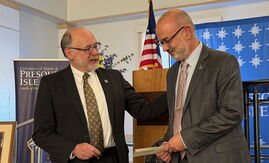UMaine System prepares to bring students back to campus, despite shutdown
The University of Maine System on Tuesday said it is drawing up plans to bring back students, employees and the public this fall to its eight schools across the state.
While complying with public health guidelines, the UMaine System “will be ready to return to face-to-face instruction if group gatherings and interaction are permissible and advisable by the end of August,” according to a news release.
“Gov. Mills and our public health partners are doing an outstanding job leading our state through the COVID-19 public health emergency,” said Chancellor Dannel Malloy. “If they deem we are ready to begin a return to normalcy by summer’s end, Maine’s public universities will be ready with operational plans and action steps to safely bring students, employees, and the public back to our campuses.”
A planning committee met last week to determine how the system will manage the process of returning to on-campus instruction. Campuses for all seven public universities and the UMaine School of Law closed March 22 in response to the pandemic, and later resumed classes online.
Two of the system’s members, the University of Southern Maine and the University of Maine at Presque Isle, subsequently opened shelters on their shuttered campuses for people experiencing homelessness.
How to transition to more “normal” brick-and-mortar operations may be a daunting task. The UMaine System enrolls nearly 30,000 students annually. Some of the seven universities have multiple campuses, and the system operates an additional 31 course sites.
To begin the potential return, the presidents of each university will discuss their plans and take questions in a public discussion at 6:30 p.m. Tuesday on the UMS Facebook page and YouTube channel.
The system has also issued a set of “assurances” to current and prospective students, pledging to:
- Prioritize student and community health in decision-making;
- Offer distance learning options where necessary;
- Accept pass/fail grades from applicants and consider grades in light of the disruption caused by the pandemic;
- Provide virtual admission events for applicants;
- Increase financial aid for students, including a 6.5% increase in tuition waivers and scholarships;
- Consider family income due to the pandemic in making financial aid awards; and
- Make fair, timely changes in student fees to reflect changes in services.














0 Comments